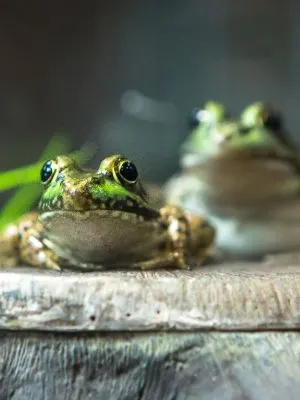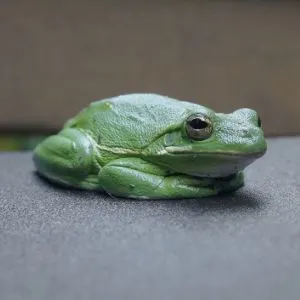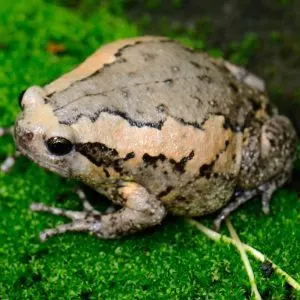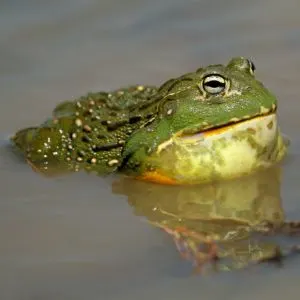Frog identification can be tough and when it comes to pet frogs narrowing down a frog species can be very difficult especially if you do not know the native geographic range of the frog.
However for wild frogs, once you know the geographic location of the frog, you can much easily narrow down the species. From here a quick online search will easily provide identification. Since there are over 5,000 new species being discovered yearly, we won’t be able to provide identification for all the species.
However, we would provide identification for the most popular pet frog species you are likely to come across. Since these frogs aren’t wild, you cannot narrow down on the species using where they currently live.
Identifying a Frog
Frogs include all members of the order Anura, this includes toads. So yes, toads are also frogs. However in common usage. Toads refer to species that have warty dry skins and are terrestrial (prefer to live on land), and frogs refer to the species with smooth moist skins and are semi-aquatic or aquatic.
1. Call/Vocalization
The sounds that a frog makes can be used to identify the frog. The sounds, calls, and croaks are usually unique to the species, genus, or sometimes the taxonomic family. Vocalization is an important tool in identifying the species.
2. Geographic Range
The geographic location of the frog can help you narrow down the species. If it is a wild frog then the area within which you spot the frog can help you determine the species. However, if the frog is a pet, you may be difficult to find out the geographic range of the species.
3. Habitat (Aquatic or not)
Frogs can be aquatic, semi-aquatic, or terrestrial. The frog can be native to ponds, pools, swaps, marshes, or even paddy fields. The frog can be endemic to frogs. It may even be a tree frog.
Some frogs such as the Natterjack Toad are native to sand dunes, and sand heaths. All of these habitats are specific to certain species. Knowing the habitat of the frog can help you to identify the species.
4. Coloration & Pattern
The colorations and patterns on the amphibian can help you determine the species. Different species have different colorations and patterns. Paying attention to these colorations is critical in determining the species.
5. Texture, Size, & Shape
The skin texture, the length of the frog, the positioning of the eyes, and many more can be used to determine the species. Some frogs may be supratympanic; some species may have dorsolateral folds while others might not.
Some frogs also have vomerine teeth. These teeth are found after their first row of teeth. Worry not, the descriptions in this article won’t be all technical.
Identifying some common pet frogs
Below are 10 of the most common frogs and toads you will come across in both the pet trade and in the wild. Key things are pointed out like size, shape, region, colors, and even the sounds they make to help you in identifying your frog.
If you are looking for a book to help with this, check out the Peterson Field Guide to Reptiles and Amphibians. It’s a pretty in depth guide with plenty of species in it.
1. American Toad

The scientific classification of this species is Anaxyrus americanus. As per the common name, this toad is endemic to North America.
Color & pattern: This frog has warty skin which may be olive, reddish, or brownish. There are several spots on the skin as well. You can sometimes find a line along the middle of its back.
Size: This toad can reach lengths of 11 cm, as an adult.
Distinguishing Feature: This toad has a long parotid gland that doesn’t reach the toad’s cranial crests.
Geographic range: The toad can be found in the eastern United States as well as in eastern Canada.
Habitat: These toads prefer areas with moderate to high humidity. You can find them in ponds, shallow parts of rivers, and shallow streams. They can also be found in gardens and on lawns.
Call: Audio: https://animaldiversity.org/collections/contributors/alan_wolf/bufo_americanus2m/file.mp3
Below is a video of an American toad doing it’s call.
2. American Bullfrog

The scientific classification of this species is Lithobates catesbeianus. These frogs are most aquatic. While they make great pets, they are also an invasive species all over the world.
Color & pattern: The dorsal color of this frog is olive-green with the underside being off-white with grayish or yellowish spots. This toad usually has brown spots all over its skin.
Size: These amphibians can reach masses of 1.10 lb or 500 grams. They have an average length of 10cm to 18 cm.
Distinguishing Feature: On either side of its head, you can find large highly visible circular eardrums.
Geographic range: These frogs are endemic to North America. However, they can be found in places such as Asia, South America, and southern Europe.
Habitat: Bullfrogs are aquatic and need to live in water to survive. They can be found in wetlands such as bogs, swamps, & marshes, rivers, streams, ponds, and lakes.
Call: The call of this species is a low and rumbling “rum, rum, jug-o-rum”.
3. White’s Tree Frog

The scientific classification of this species is Litoria caerulea. These tree frogs are native to Australia and are commonly kept as pets. These are also called the Australian green tree frog. It is known as the White’s tree frog in honor of John White who described the species in 1790.
Color & pattern: The coloration of this amphibian is bluish-green to emerald green. It may have white or yellowish spots on its sides. The underside of this frog is white and actually ough in texture.
Size: Adult specimens grow to lengths of 7 to 12 cm or 3 to 4.5 inches. Most females are 4 inches in length while most males are just 3 inches in length.
Distinguishing Feature: Distinguishing features include its bluish-green skin color as well as the fatty ridge over each eye. Their parotid gland is also quite large.
Geographic range: This amphibian can be found in the eastern and northern parts of Australia as well as the southern part of New Guinea.
Habitat: This frog isn’t aquatic but prefers areas of high humidity. These amphibians can control their body temperature by controlling the amount of water that evaporates through their skins. They can be found in moist forests as well as suburban and agricultural lands. They are seen near lavatories, reservoirs, and water tanks.
Call: This call almost sounds like a small duck in a way.
4. Madagascar Tomato Frog

The scientific classification of this species is Dyscophus antongilii. This turtle is part of the genus Dyscophus made up of two other tomato frogs.
Color & pattern: The name of this frog tells us a lot about its coloration and patterns. This amphibian is reddish-orange in color. This bright coloration makes the amphibian easy to identify. Males of the species are more brownish. The frog also has a black streak that goes from right behind the eye to the abdomen.
Size: This amphibian goes to lengths of 6.5 cm and 41 grams for males and 230 grams and 10.5 cm for females.
Distinguishing Feature: The coloration and black streak from behind the eye to the abdomen are this species distinguishing features.
Geographic range: This frog is endemic to Madagascar. They are also relatively popular in the pet trade.
Habitat: These frogs can be found in rainforests and scrub forests.
Call:
5. Oriental Fire-Bellied Toad

The scientific classification of these frogs is Bombina orientalis. This species is endemic to Korea, parts of Russia, and China. This fire-bellied is so called because of the bright red coloration of its underside.
Color & pattern: The dorsal coloration ranges from bright green to brown. There may be dark blotches on its green dorsal coloration. The underside of this species and in fact the entire genus – Bombina is bright orange-red with dark spots. This coloration is what gives the species its common name.
Size: Adults reach lengths of 2 or 3 inches.
Distinguishing Feature: The bright orange-red or yellowish coloration of its ventral surface distinguishes fire-bellied toads. Oriental fire-bellied toads also have bright green or brownish-gray dorsal surface.
Geographic range: These toads are native to southern Japan (Tsushima, and Kyushu), Thailand, China, and Korea. In russia, they can also be found in the Khabarovsk and Primorye regions.
Habitat: This species can be found in open meadows, swampy bushlands, river valleys, deciduous forests, and pine or spruce forests. They can be found usually close to water bodies such as streams and rivers, ponds and lakes, and temporary water bodies such as puddles and ditches.
Call: These have almost like a wind type sound which is a little bit eerie.
6. American Green Tree Frog

These frogs are normally called the green tree frog. The scientific classification of this species is Dryophytes cinereus or Hyla cinerea.
Color & pattern: These frogs are green with milky white undersides. The dorsum area can however be reddish brown.
Size: Males generally reach lengths of 1.3 inches to 2.5 inches (3.2 cm to 6.4 cm) with females being larger.
Geographic range: The species are endemic to the southeastern and central United States.
Habitat: These frogs are endemic to streams, marshes, lakes, and ponds. They can also be found in forests, swamps, and marshes.
Call: These have an almost chirping type sound
7. Burmese Chubby Frog

This species is also known as the banded bullfrog, the rice frog, the Asian painted frog, the bubble frog, the Malaysian painted frog or simply as the chubby frog. The scientific classification of this species is Kaloula pulchra.
Color & pattern: These frogs have rounded bodies that are salmon pink to copper brownish in color. The rounded appearance of this frog gives it its common name. The ventral surface is pale in color. The species also have a large pale band from behind each eye to the abdomen.
Size: These amphibians grow to lengths of 2.5 to 3 inches or 7 to 8 cm.
Distinguishing Feature: These frogs are chubby in appearance. They also have large pale/cream bands from behind their eyes along their sides.
Geographic range: These amphibians can be found in Myanmar, Bangladesh, Malaysia, and eastern India.
Habitat: They are generally found in paddy fields and forest floors.
Call: This has an almost cow type sound to it as if you were mooing.
8. African Bullfrog

These frogs are also known as pixie frogs and can be found in central and southern Africa. The scientific classification of this species is Pyxicephalus adspersus.
Color & pattern: The dorsal surface of females is light brown or olive and their throat area is milk-white. For males, the dorsal surface is olive and their throat area is yellowish to orange in coloration.
Size: These frogs are large and can weigh over 4.4 lb or 2 kg. Males are usually about 9 inches long and females are usually about 4 to 5 inches long.
Distinguishing Feature: These frogs are large. They are among the largest frogs in the world. Also, they have lateral ridges along their dorsal surface.
Geographic range: These frogs are mostly found in central and southern Africa. Wild populations can also be found in Nigeria in West Africa and Somalia in East Africa.
Habitat: These frogs can thrive in deserts for years and even in regions where temperatures are below freezing. They generally inhabit arid regions and grasslands.
Call:
9. Poison Dart Frogs

Dart frogs are frogs species of the family Dendrobatidae. Although these frogs are called poison dart frogs most species of poison dart frogs aren’t poisonous. And the species that exhibit high toxicity are those that feed mainly on termites, motes, and ants.
Color & pattern: These frogs are brightly colored. Their dorsal surfaces display bold color patterns.
Size: These frogs are generally small with most reaching lengths of just 0.6 inches or 15 mm.
Distinguishing Feature: These frogs are tiny and display vivid coloration and aposematic patterns. Irregular patterns of two to four colors. Their tiny size and brightly colored skin make them easy to identify.
Geographic range: These amphibians are endemic to central and south America.
Habitat: They prefer humid forests, swamps, lakes, marshes, and rivers.
Call: Audio – https://animaldiversity.org/collections/contributors/collin_fisher/DauratusCall/file.mp3
10. Red-Eyed Tree Frog

The scientific classification of this species is Agalychnis callidrya. These amphibians are among the most commonly kept frog species. They are called ed-eyed tree frogs because they have huge red eyes.
Color & pattern: This amphibian is vividly colored. Their dorsal surface is green with blue and yellow or cream vertical stripes on their sides. They have red or orange feet and blue upper legs. This species’ most distinguishing feature however is its big bright red eyes.
Size: These frogs grow to lengths of 2 to 3 inches.
Distinguishing Feature: This species’ most distinguishing feature however is its big bright red eyes. Red-eyed tree frogs are also very colorful.
Geographic range: these frogs are endemic to Central America.
Habitat: these tree frogs live in trees. They can be found in rainforests.
Call:
Conclusion
There are several ways to identify a frog. You can use the physical appearance and even the calls of the frog to identify the species. The geographic range of the species can also help you to narrow down the frog species. However, with pet frogs, it isn’t always possible to determine the amphibian’s geographical range.
There are over 5000 frog species in the world with new species being discovered yearly. These include toads. As many of you already know, toads are in fact frogs. Toads can usually be distinguished by their weary rough skin. However this isn’t always the case.
If you have any questions or additional information, kindly leave a comment.
Table of Contents
